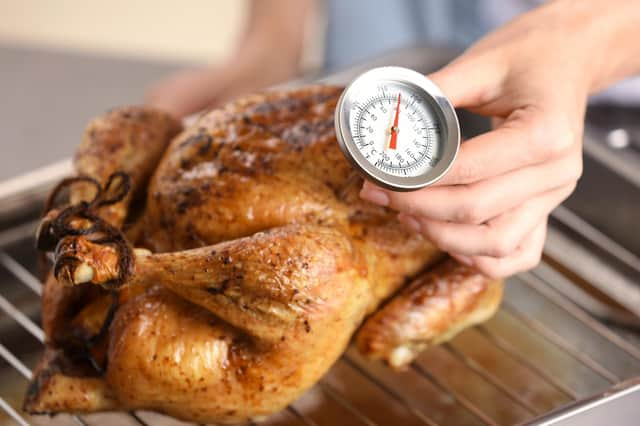How to eat chicken safely: Why you should never wash raw chicken, how to prepare and cook it


Chicken, the basic stalwart of many Scottish family meals, needs careful prep to keep people safe.
Foods Standards Scotland has prepared a simple set of guidelines to ensure Scots keep their kitchens germ free.
Never wash raw chicken
A simple prep-mistake could land you with a nasty, and potentially fatal, form of food poisoning called campylobacter.
Improper handling and cooking of raw chicken is particularly dangerous to the over 65s, due to their immune systems weakening as they get older.
The food safety message is simple: never, ever wash raw chicken.
What is campylobacter?
It’s a bacterial food poisoning, often contracted through poor food handling and cooking of raw chicken. It is the most common form of food poisoning in Scotland and the rest of the UK. The symptoms are nasty, particularly in vulnerable groups, where extreme diarrhoea can be extremely unpleasant, or even life-threatening. A severe case can see the elderly hospitalised, or worse.
How is it spread?
Environmental exposure – for example contact with farm animals – is one source, but poor food handling and cooking is often the cause.
Washing raw chicken isn’t necessary (cooking at the correct heat for the right amount of time kills any bacteria), and instead washing chicken spreads bacteria from the raw meat itself on to surfaces around the kitchen.
The Four Cs
Follow these four simple steps to ensure your family favourite is safe to eat.
Chilling: Always defrost chicken in a covered container on the bottom shelf of your fridge, away from other cooked foods, to avoid the juices spilling out and contaminating other foods and surfaces. Never defrost at room temperature. Make sure the meat is fully defrosted before cooking.
Cleaning: Always wash your hands in warm, soapy water after handling raw chicken. This stops campylobacter from spreading onto other food or surfaces, including kitchen cloths etc. Make sure you clean knives and cutting surfaces thoroughly in warm, soapy water immediately after use and before using them for any other food.
Avoid Cross contamination: Never wash raw chicken. This is one of the common causes of campylobacter spread, as it splashes harmful bacteria on to surrounding surfaces. Just like an uncontained sneeze spreads germs over a wide area, washing chicken projects tiny droplets around the kitchen sink and surfaces – even onto clean dishes on the kitchen drainer! Use different chopping boards for raw chicken and ready-to-eat or cooked foods (such as salads and vegetables), or if you can’t do that, wash the board thoroughly in warm, soapy water between ready-to-eat or cooked foods.
Cooking: Make sure the chicken is cooked properly, right the way through till there is no pink meat and the juices run clear. It should be 75˚C in the thickest part of the meat, and steaming hot in the middle. By cooking chicken properly, all potentially harmful bacteria is killed off in the process, with no need to ever wash raw chicken.
You can find out more about the 4Cs and the campaign to cut the risk of campylobacter at Food Standards Scotland.